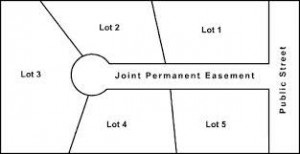Subdividing Property for Modular Homes
Let’s say your parents (or grandparents, or children for that matter) have a piece of property with a house on it. You would like to build on a section of that property. We see it almost every day. Many families are considering ways to move closer to help with caregiving, cut expenses, and make life a little simpler. Let’s talk a little today about how to go about it.

The first thing you will find out if you go to a bank to finance the project is that you cannot put two homes on one property. Why you may ask? The bank requires a lien against the property for any mortgage. The lien must be against a livable house, on a foundation, and the land it sites on. This allows the bank to sell the house and property if the mortgage is defaulted on. This means that you will need to subdivide the property to get a mortgage. Before we go on, let me clarify that if you are purchasing a sectional home to be placed on piers, there are conventional loans that will allow you to place this type of home on a piece of property with an existing home already on it. We can explain both of these options to you in more detail. Here are the steps you will need to take to subdivide a piece of property, and place your new home on it:
- Determine the County and Township that the land is located in. (You may need to get a 911 address.)
- Contact the township supervisors about their subdivision regulations. Here are the questions you should ask:

Minor Subdivision 
Major Subdivision - Ask about minimum amount of land you can subdivide. You will need to verify if the land was subdivided before. There are major and minor subdivisions. Most times major subdivisions are over 5 lots and minor are under 5 lots.
- Ask about road frontage requirements.
- Ask about easements and right of ways .
- Ask about setback requirements (How far from the property lines does the house need to be?)
- Ask about well location. (Many times, the well and septic have to be a certain distance apart.)
- Ask about septic requirements – they should be able to give you the name of the company/person who will do the perc test.
- Verify that you are not in a flood plan or wet lands.
- Verify if you need to take subdivision drawings to a township meeting for approval.
- Determine approximate location of the house on the property given the subdivision requirements. You will want to consider the distance from road and the cost of driveway and utilities to site. Consider what type of basement you want (crawlspace, full foundation – in ground or walkout). You may want to meet with an excavator at this point to discuss possible location and costs. The final location will also depend on the perc test results.
- If your site has municipal sewer on it, you will need to find out if any taps are available and how much they cost. You will not need to do any perc testing on the property if you have access to a sewer system.
- Meet with septic enforcement company (aka the perc test person). This name should have been given to you by the township supervisor. For a perc test, typically you will need to dig two pits with a backhoe and 5 or 6 small holes with a post hole digger. The septic enforcement agency will tell you exactly what size holes to dig and how many.
- Once you receive your perc test results, you may need to get an engineer to design a septic system for you. (Double check with septic enforcement agency) You will need to know the number of bedrooms and bathrooms you plan to build.
- You will need to get a surveyor to survey the land.
- You will need to get an attorney to draw up a new deed with the land in your name.
Next time, we will discuss what steps to take to place your new home on this property. It can take a fair amount of work, but to get the piece of property you want, it’s worth it! As always, contact us here with any questions.

